
Have you ever wondered how some people build a strong, athletic upper body without ever using a gym?
Well, surprisingly, it doesn’t require buying lots of fitness tools or sacrificing hours mastering callisthenics.
So in this post, I’m going to show you the suspension training roadmap that’s helped over 8000 busy adults…
Build impressive upper body muscle, strength, and mobility using just TRX suspension training.
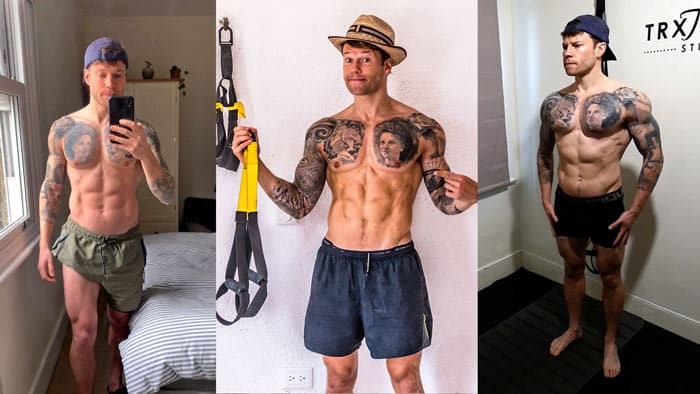
To start, let me show you how to unlock your primal movement patterns…
So you don’t pick up any injuries…
Don’t have time to read the post in full? Then watch the video below for the step-by-step minimalist bulletproof upper body training…
Table Of Contents
Primal Movement Training
Our ancestors climbed, crawled, and hung from trees every single day.
But today’s desk-bound lifestyle has locked up our shoulders, rounded our backs, and weakened our grip.
Think about rock climbers.
They regularly hang, stretch, and reach in every direction
Resulting in remarkable shoulder mobility and impressive upper-body resilience.
This first step isn’t about aesthetics.
It’s about reclaiming your body’s natural mobility and posture so you can move confidently, freely, and without pain.
But how can you do that without complicated physio routines or endless posture exercises?
Let me show you how to reverse years of negative posture and regain your shoulder mobility with just two simple moves.
Unlock frozen, immobile shoulders.
This is where a TRX suspension trainer comes in handy.
The Y-T-L movement is your key to unlock frozen, immobile shoulders.
- Keep your shoulders pulled back and your arms slightly bent.
- Start by raising your arms into a Y shape, then flow smoothly into a T shape, and finally into an L shape.
- Move slowly, focusing on controlled, fluid movements to build functional strength and restore shoulder mobility.
Then move on to TRX Facepulls, a powerful rear shoulder exercise.
Reverse years of negative posture
TRX suspension trainer facepulls are your secret weapon exercise for correcting rounded shoulders.
- Grab your suspension trainer and lean back at a slight angle, nothing too extreme to start.
- Pull the handles toward your face, aiming roughly at nose level.
- As you reach the top, rotate your knuckles upward, squeezing your shoulder blades together.
- Hold that squeeze for a solid two or three seconds, then slowly lower yourself down, keeping your elbows slightly bent at the bottom.
- Don’t just hang, or you’ll lose tension in your back and shoulder muscles.
- Aim for 8–10 reps, completing 3 sets.
Once you’ve nailed the basic form, increase the challenge by leaning back further or slowing down your lowering phase.
Remember, slow and controlled is the key here.
Once you’ve reclaimed this primal mobility, you’ll be ready for the next step: building noticeable upper-body muscle.
Muscle Building Suspension Training
I used to think a bigger chest meant a heavier bench press
But when I switched from traditional gym training to minimalist bodyweight training, I discovered a powerful truth:
Your muscles don’t know weight—they only recognise tension.
Slow, controlled movements using a muscle-centric suspension training technique beat heavy lifting every time for sustainable, safe, and noticeable lean muscle growth.
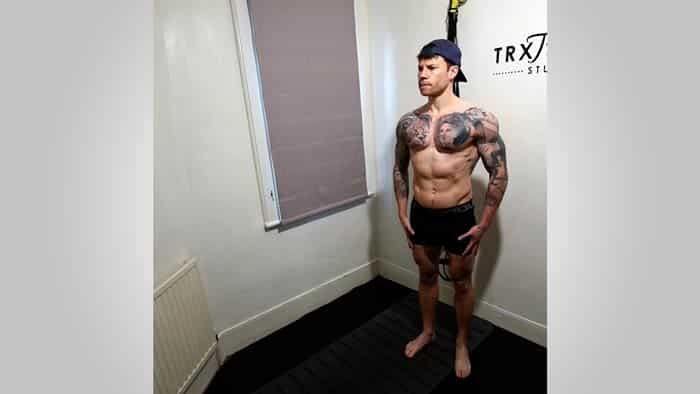
Most people rush through exercises, focusing only on hitting high rep numbers.
This is what we call “movement-centric training,” and it’s a mindless mistake.
Sure, you’ll work up a little sweat—but your chest muscle, for example, isn’t getting enough direct tension to actually grow.
Because you’re spreading the bodyweight load across your shoulders, triceps, back, and biceps.
No individual muscle takes enough load to create a powerful muscle-building stimulus.
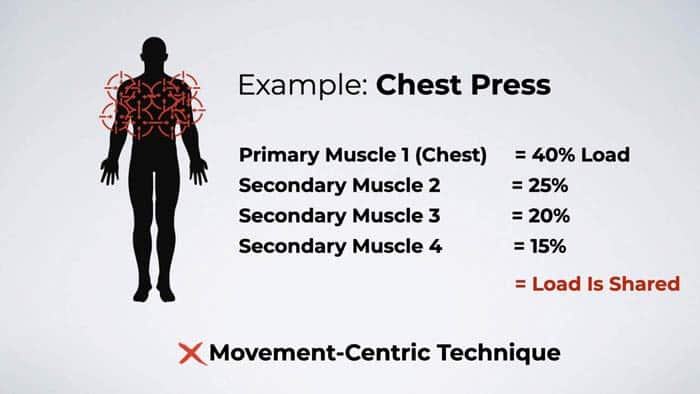
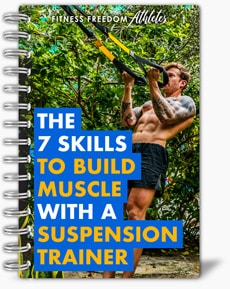
Get Your FREE Copy Of My ‘7 Skills To Build Muscle With A Suspension Trainer Handbook!’
Downloaded 70,000+ times! Just tell me where to send it:
Instead, use Muscle-Centric suspension training Technique.
This method uses slow, controlled movement and your powerful mind-muscle connection to isolate individual muscles and place all the load onto them
But how exactly can you apply muscle-centric training using only your body weight to build visible muscle?
Let’s look at the chest press example again, this time with muscle-centric suspension training technique:
- First, activate your chest by imagining you’re squeezing a pencil between your pecs.
- Next, lower yourself slowly for a count of 4 seconds, feeling the stretch in your chest at the bottom position.
- Then push yourself back up and focus on bringing your elbows together at the top and squeezing your chest muscle hards
By slowing the movement down and focusing your mind-muscle connection you can isolate your chest muscle and place the majority of your bodyweight load onto it.
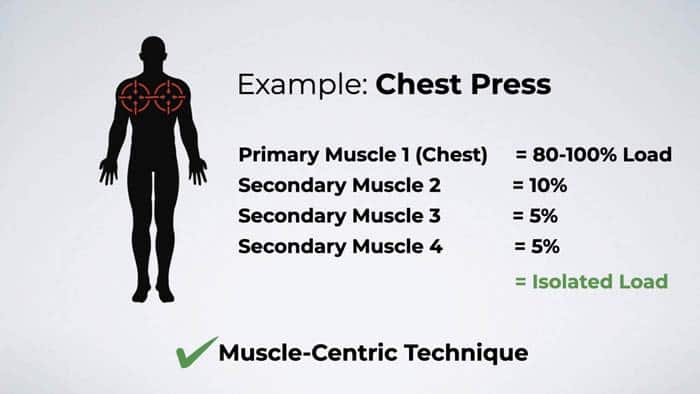
This creates a powerful stimulus for muscle growth.
Now, this muscle-centric approach won’t get you a bodybuilder torso.
But when you apply it to every exercise for your upper body, it will give you a strong and defined upper body for long-term mobility and longevity.
It’s the same approach I use in my lean muscle-building TRX suspension trainer programs.
Most conventional training methods completely overlook this approach.
They focus on heavier weights and partial ranges of motion, which was exactly the mistake I used to make.
But the real secret to healthy muscle growth and lasting mobility is training through your muscle’s full range of motion.
Which is exactly what we’ll tackle next.
Ranges of Motion Training
Gymnasts have strong, agile bodies because they don’t just train in partial ranges
they build strength through full, complete movements, even in extreme positions.
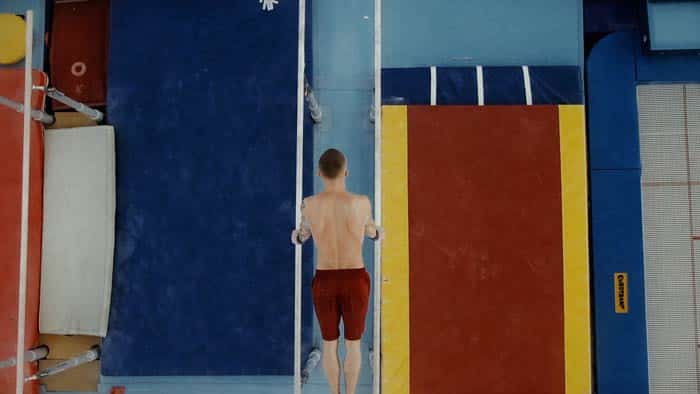
We call this “full range of motion training,” and it’s your secret weapon for fixing…
- muscle imbalances
- relieving joint pain
- and strengthening your entire posture.
But how exactly can you apply this without being an elite gymnast?
Let me break it down, so you can start getting maximum functional strength from every rep you perform.
Improving your range of motion
First, take the upper body exercises you’re already doing and extend them through their entire range, not just the comfortable middle zone.
For every rep, you want to feel a full stretch on your muscle at one end, and a powerful squeeze at the other.
For example, if you’ve been doing partial rows or curls, it’s time to expand that range.
You might need to slow down your movements or temporarily reduce the weight, but trust me—the payoff is huge.
Next, add exercises specifically designed to challenge your muscles in their stretched-out positions.
A great example is suspension trainer chest flys.
Where you lower down until your chest muscles fully stretch before pushing back up.
Or overhead triceps extensions, where you feel the stretch in your triceps before driving up again.
By consistently practising these deeper, fuller movements with every exercise you do…
You’ll gradually unlock strength, mobility, and control you never knew you had.
Now that you’ve mastered training for mobility and full muscle activation, let’s move onto the next critical step:
building genuine upper body strength.
Strength Training
Most people obsess over the “mirror muscles”—the chest, shoulders, and arms because that’s what they can see.
But without rock-solid back strength as your foundation, you’ll always have imbalances that lead to injuries and poor mobility. For…
- Parents
- Weekend warriors
- Or active seniors…
Who value functional strength and longevity over a six pack, prioritising your back strength, offers something far more valuable—resilience.
But how do you build a strong back without heavy weights or pull-ups?
Let me show you two simple row exercises that’ll dramatically boost your upper-body foundation.
First: the Suspension Trainer Low Row.
This targets the sides of your back—think of these muscles as your foundational pillars.
- Start by leaning back, arms extended, and feeling a gentle stretch at the bottom.
- Now drive your elbows back and down close to your sides, to drive upwards.
- Pause at the top for a solid squeeze, really feeling those back muscles engage.
- the slowly lower yourself back down, extending your arms to get that beneficial stretch at the bottom.
Now let’s move onto the second TRX exercise…
The Suspension Trainer wide row or high row.
This targets your upper back, crucial for a strong posture and shoulder girdle
- Again, start with arms extended, leaning back slightly.
- This time, drive your elbows up and out, pulling yourself toward the anchor point.
- Squeeze your shoulder blades together at the top, pausing to really feel the upper back muscles engage.
- Slowly lower yourself back down, stretching at the bottom.
Master these two movements, and you’ll build a back that’s not just strong, but resilient.
Now that you’ve got these foundational exercises in your arsenal,
let me show you how to boost your functional strength even further with the power of isometric holds.
Isometric Training
Think back to that rock climber again, halfway up a cliff face.
They’re frozen in place not moving an inch, yet their muscles are firing at maximum intensity just to hold position.
That’s exactly what isometric training is all about—building strength through sustained tension rather than movement.
But why does this matter to you?
Because this kind of strength is incredibly useful in everyday life whether you’re…
- Holding your child
- Carrying a heavy bag
- Or simply maintaining good posture at your desk.
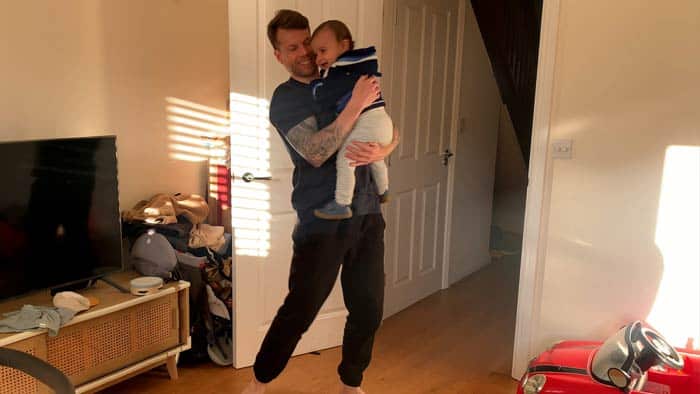
Recent studies keep revealing new benefits of isometric exercises, like lowering blood pressure and even boosting important hormones—such as testosterone.
So how exactly can you harness this powerful technique to bulletproof your own upper body strength?
It’s actually easier than you think. Let me show you how.
Harnessing the power of isometrics
First, let’s start with your pushing muscles.
Grab your suspension trainer and set yourself up in a stable, athletic stance.
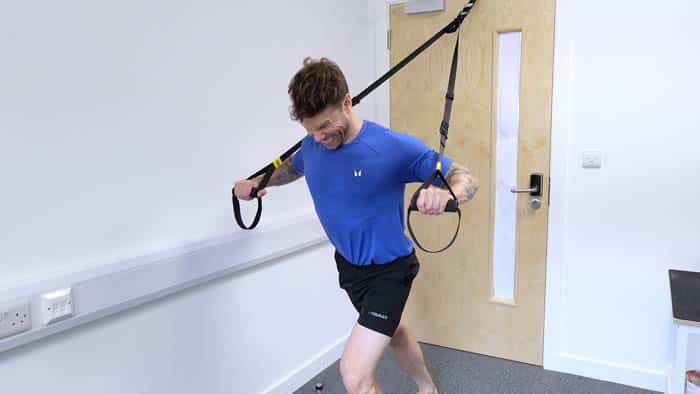
- Position your arms as if you’re about to do a chest press.
- Now, push firmly against the straps without actually moving. Imagine you’re trying to push through a wall.
- Gradually increase your effort, squeezing your chest, shoulders, and arms tighter and tighter.
- Hold this position with maximum effort for as long as you can.
Next, switch to your pulling muscles.
Set yourself up again, but this time, pull against the straps as if you’re trying to pull a heavy door closed.
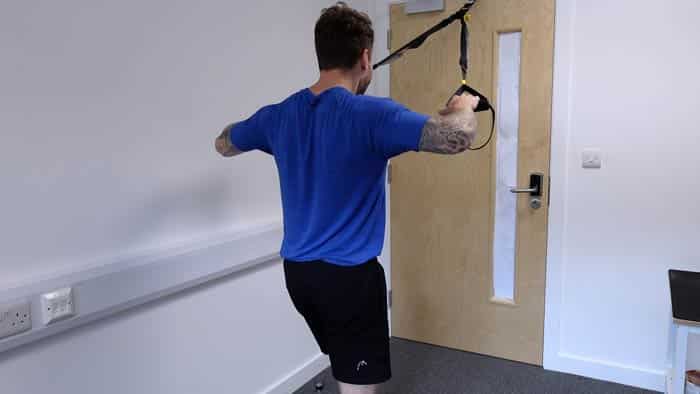
Remember, the goal isn’t to actually move —it’s to fire up every muscle in your upper body.
Hold these maximum effort push and pulls for as long as possible.
These exercises look deceptively simple, but trust me—you’re activating every muscle fiber in your upper body simultaneously.
The intensity is real.
Now, let’s move into arguably the most essential skill in your minimalist upper-body training toolkit:
Core Stability.

Get Your FREE Copy Of My ‘7 Skills To Build Muscle With A Suspension Trainer Handbook!’
Downloaded 70,000+ times! Just tell me where to send it:
Core Stability
Think of your core like the trunk of a tree.
You can have the strongest branches—your arms—and the toughest roots—your legs—but if your trunk is weak, the entire tree becomes unstable.
Every time you push, pull, or lift something, a weak trunk can crumble and compromise everything else.
But do you really need those fancy, complicated suspension-training moves you see on Instagram to build a rock-solid core?
Absolutely not.
Let me show you a simple, practical way to strengthen your core and build your ab muscles today.
Building Core Stability and ab Muscles with Suspension Training
No matter what fitness level you’re at, start with elevated suspension training planks.
Are they flashy? No.
Are they incredibly effective? Absolutely.
Once you’ve mastered elevated planks, you’re ready to add an advanced exercise: supermans.
Supermans are fantastic because they’re one of the few exercises that fully engage your abs through their entire range of motion.
You stretch your abs at the bottom, then powerfully contract them at the top.
The key is to go slow.
Focus on a controlled movement stretching at the bottom and squeezing your abs tightly at the top for maximum core strength.
Now, how exactly do you integrate any of these training elements into your training routine?
Let me show you how to craft a simple, effective program—whether you’re a complete beginner, intermediate, or advanced.
So you can steadily build a bulletproof upper body at your own pace.
Working This into Your Suspension Training Routine
I always advise my clients to start with a foundational muscle-building suspension trainer workout.
Then layer on the specific training elements depending on their own challenges.
So first, here’s exactly how to create your own suspension-trainer muscle-building Workout for your current level and objectives…
First, let’s cover the Beginner Level…
Beginner Level Suspension Training
This is for you if…
- New to using a suspension trainer
- Low – average fitness level
- Low – average lean muscle mass
If your goal is Maximise building muscle and adding size…
- Use an Upper / lower body workout split (one-day training upper, one-day training lower).
- This allows you to maximise volume on each body to achieve muscle breakdown and rebuild stronger.
- 8 – 10 reps / 1-2 sets.
- 4 times a week (2 upper and 2 lower).
- Stick to simple exercises and master them – chest press, back row, bicep curls etc
Checkout my Total Body Transformation Program if you’re interested in trying this out
If your goal is Maximise getting lean and sculpted….
- Full body workouts. Train the main areas of your entire body every workout.
- Increases your cardiovascular output because there is more demand from every major muscle area. And you burn more fat.
- 10 – 15 reps. 1-2 sets. This means you will develop good muscle tone whilst burning fat.
- 4 times a week.
- Stick to simple exercises and master them – chest press, back row, bicep curls etc
Checkout my Total Body Enhance Program if you’re interested in trying this out
Now let’s cover the Intermediate Level
Intermediate Level Suspension Training
This is for you if…
- 1 – 2 years using a suspension trainer
- Average fitness level
- Average lean muscle mass
If your goal is Maximise building muscle and adding size…
- Antagonistic muscle pairing workout split. Which means training opposite muscle groups. E.g chest and back.
- Add in dropsets and giantsets to get more time under tension = muscle growth
- 8 – 10 reps with 3 sets.
- 4 – 6 times a week.
- Add in accessory exercises that target smaller muscles. Along with compound exercises, like chest press.
Checkout my Muscle Builder Program if you’re interested in trying this out
If your goal is Maximise getting lean and sculpted….
- Full body workouts. Train the main areas of your entire body every workout.
- Increases your cardiovascular output as there is more demand. So you burn more fat.
- 12 – 20 reps. 3 sets. Plus single sets aiming for 40 reps with pause-rests.
- 4 times a week
- Add in dropsets for increased time under tension and neurological stimulus.
Checkout my Beach Body Program if you’re interested in trying this out
Now let’s cover the Advanced Level
Advanced Level Suspension Training
This is for you if…
- 3 – 4+ years using a suspension trainer
- High fitness level
- Good lean muscle mass
If your goal is Maximise building muscle and adding size…
- Full body workouts. Train the main areas of your entire body every workout.
- Train to complete failure across your muscle’s 3 strength ranges: positive, negative, and isometric (the squeeze).
- Do partial reps, isometric holds, and rest-pause sets to help you achieve this.
- Ensure quality training, not quantity. Compound exercises like chest press and occasional accessory exercises like facepulls
- 6 – 8 reps with 2 sets.
- Only train again when recovered (2-3 days later)
Checkout my Full Body Athlete Program if you’re interested in trying this out
If your goal is Maximise getting lean and sculpted….
- Push / Legs / Pull workout split so you can achieve high volume on targeted body areas.
- Giantsets on most exercises to maximise time under tension for every muscle.
- 10 – 15 reps inside gaintsets. Focus on chasing the ‘pump’ and burn to maximise fat burning and muscle toning.
- Incorporate a variety of exercises including lots of accessory and compound movements.
- 6 times a week.
Checkout my Ultimate Physique Sculptor Program if you’re interested in trying this out
For every workout
For every workout, increase reps and sets week to week for progressive overload.
Once you’ve got your muscle building program sorted, then add in addition variables that you are most weakest at onto the end of each workout.
For example, you may have poor posture, so at the end of each workout, add the posture training variable.
Once that improves, you may need to work on your core. So then add that training variable onto the end.
Then try improving your range of motion of every exercise
One additional training variable at a time.
And if you want to know How to Build Bulletproof Legs With Suspension Training checkout this post for the step by step guide
Here’s to your Fitness Freedom!
Coach Adam

 I hope you enjoy this post. If you want my help to build lean muscle & transform your body using a TRX suspension trainer anywhere –
I hope you enjoy this post. If you want my help to build lean muscle & transform your body using a TRX suspension trainer anywhere – 
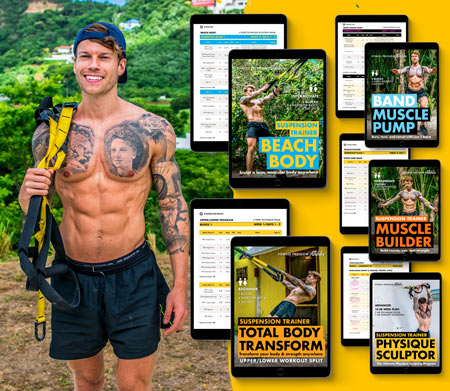
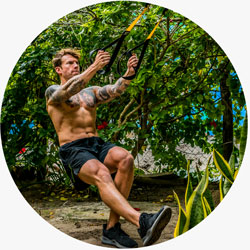
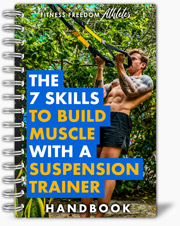
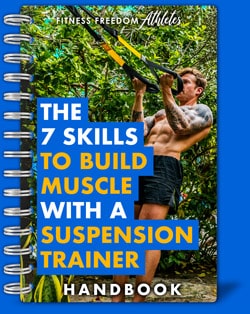

0 Comments